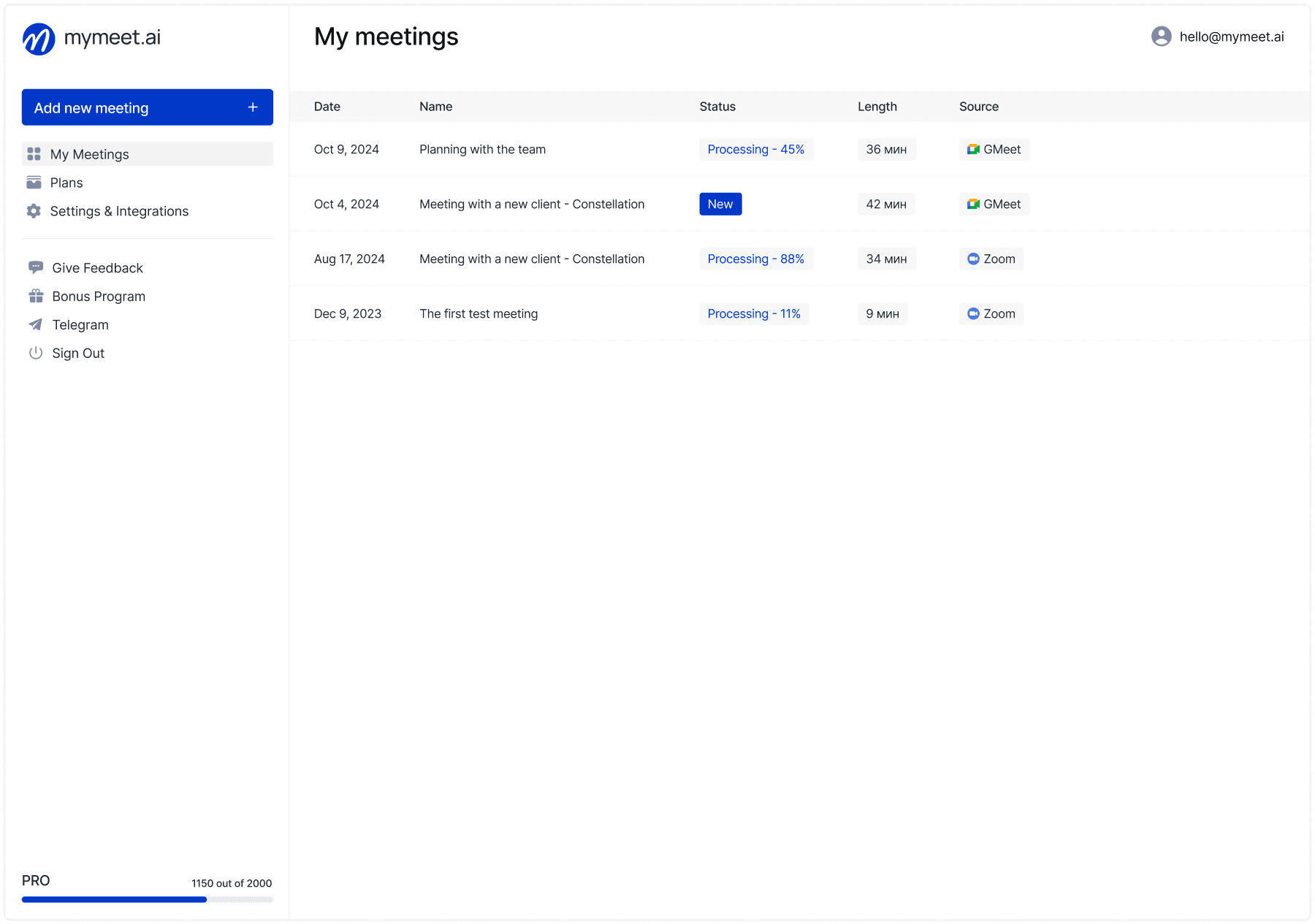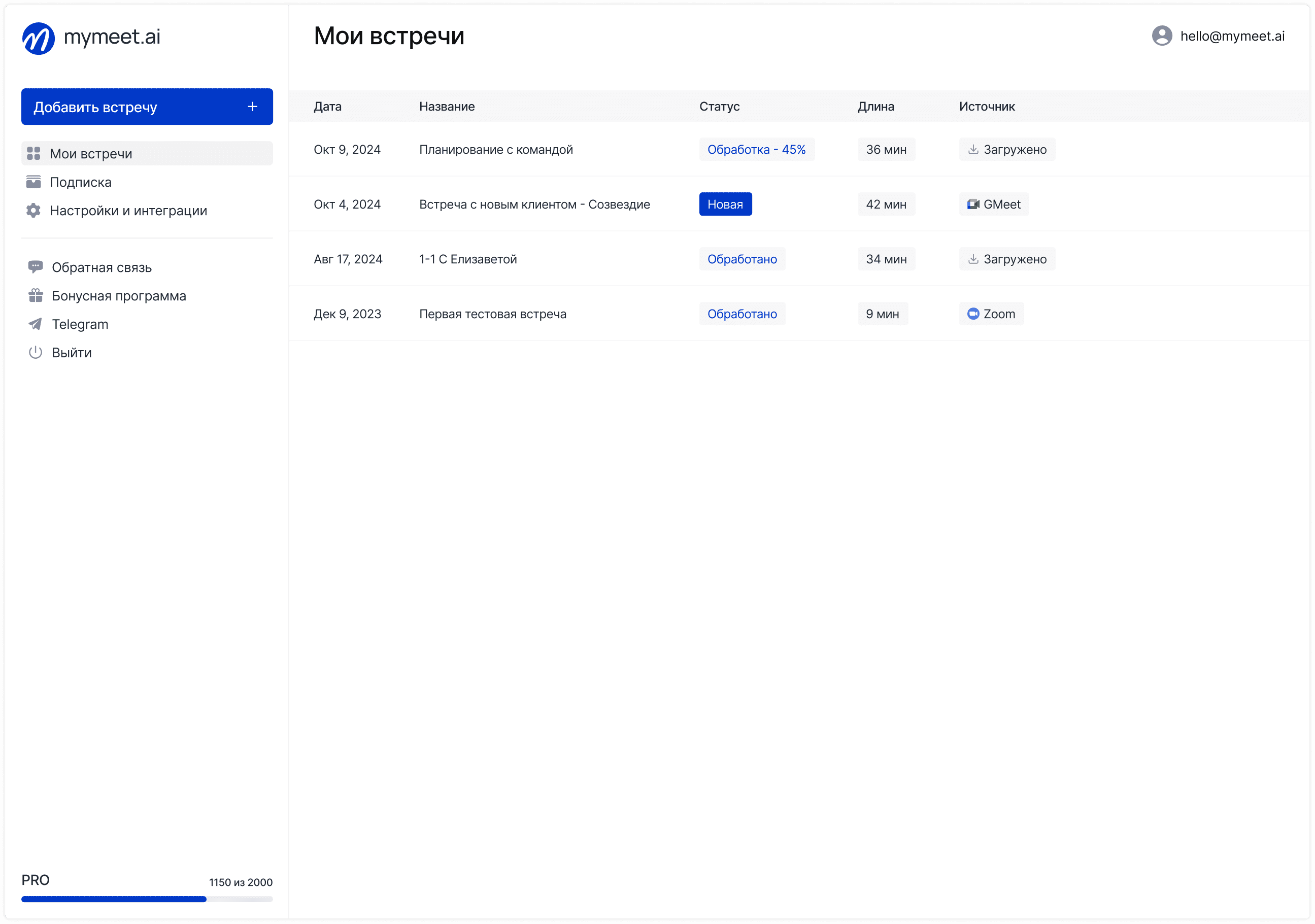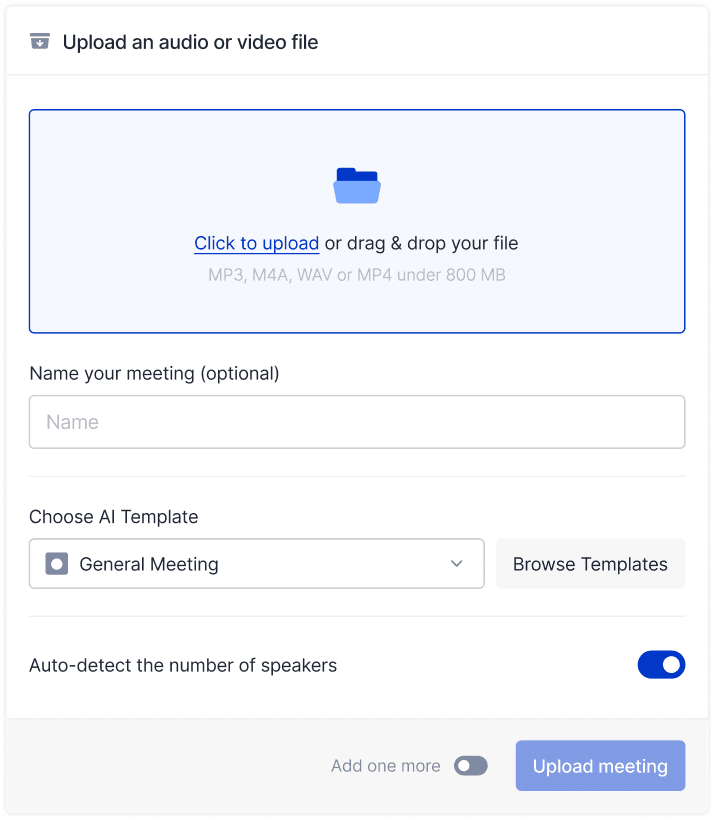Technology & AI

Andrey Shcherbina
Jul 25, 2025
An e-commerce company with a 300-person team faced critical HR problems: staff turnover reached 35%, hiring processes stretched for months, and personnel needs forecasting was based solely on intuition. After thorough market analysis and testing various solutions, a combination of 4 specialized HR tools was chosen. Results exceeded expectations: hiring time decreased by 60%, resignation prediction accuracy grew to 87%, and ROI from training programs increased 2.5 times.
The mymeet.ai team studied the HR analytics tools market and compiled a ranking of the most effective solutions for global business. The right platform choice determines data-driven HR success and quality of personnel decisions.
HR Analytics Tool Selection Criteria
Choosing an HR analytics platform requires evaluation of technical, functional, and compliance aspects with consideration of global business standards.
Functionality and Metric Coverage
Tools should cover key HR tasks: metric calculation, data visualization, forecasting. Specialized HR solutions are preferable to universal BI platforms thanks to ready metrics and industry templates.
HR System Integration
APIs and ready connectors with HRIS are critically important for data collection automation. Support for popular international systems (Workday, SAP, Oracle) can be a decisive selection factor.
Ease of Use
Self-service analytics and intuitive interface allow HR teams to create reports without IT support. Drag-and-drop builders and mobile applications accelerate insight generation.
Regulatory Compliance
Data protection compliance, consent management, and security certifications are mandatory for global companies. Support for international standards simplifies compliance.
Total Cost of Ownership
TCO includes licenses, implementation, training, and support. Per-user or flat-rate models differently affect project economics depending on company size.
Top 10 Best HR Analytics Tools
When compiling the ranking, we considered functionality, implementation simplicity, support quality, and compliance with international requirements.
1st Place: mymeet.ai — Revolution in HR Communication Analysis

Mymeet.ai represents a fundamentally new approach to HR analytics through automatic AI analysis of interviews, candidate meetings, and employee interactions. Advanced development created with understanding of global HR market specifics and regulatory requirements.

The platform stands out with a unique combination of advanced natural language processing technologies and deep understanding of HR processes. Unlike traditional HR analytics tools working with structured data, mymeet.ai extracts insights from unstructured information — interview and meeting recordings.
Key mymeet.ai capabilities for HR analytics:
✅ Automatic candidate interview analysis — identifying competencies, soft skills, cultural fit

✅ AI-powered interviewer quality assessment — analyzing question types, depth, objectivity
✅ 1-on-1 meeting topic monitoring — identifying discussion patterns, problem areas, development needs
✅ Employee feedback analytics — automatic insight extraction from performance reviews

✅ Resignation prediction — analyzing changes in communication tone and content
✅ HR system integration — automatic candidate and employee profile updates
✅ Enterprise-grade security compliance — full data protection and confidentiality requirements
✅ API for custom integrations — capability to embed into existing HR ecosystems
Train employees to work with the AI assistant. Submit an application via the form for a corporate webinar.

Mymeet.ai opens new HR analytics dimensions unavailable to traditional tools. Live communication analysis with candidates and employees provides unique insights about motivation, corporate culture fit, and hidden team problems. The platform is especially effective for companies with active hiring and personnel development processes.
2nd Place: Workday HCM — Comprehensive Platform for Large Business

Workday offers integrated personnel management solutions with powerful analytical capabilities. Suitable for large international companies with 1000+ employees.
Main capabilities:
Predictive analytics for turnover forecasting and succession planning
People analytics with machine learning for talent identification
Benchmarking with other company data for comparative analysis
Advanced reporting with 400+ ready reports
Mobile dashboards for leaders at all levels
Workday requires significant implementation and training investments but provides enterprise-level functionality for complex HR processes.
3rd Place: BambooHR — Simplicity and Efficiency for Medium Business

BambooHR focuses on ease of use and quick implementation for companies from 50 to 500 employees. Intuitive interface and ready analytical reports.
Key functions:
Time-off tracking with vacation usage analytics
Performance management with 360-degree feedback
Customizable reports across all HR metrics
Employee satisfaction surveys with automatic analytics
Cost-per-hire calculator with source breakdown
BambooHR is optimal for companies needing functional HR analytics without enterprise solution complexity.
4th Place: Microsoft Viva Insights — Productivity Analytics in Microsoft Ecosystem

Microsoft Viva Insights analyzes Office 365 data to assess employee productivity, collaboration, and well-being. Natural integration with Microsoft corporate systems.
Main capabilities:
Meeting analytics — analyzing meeting effectiveness and calendar time
Email patterns — assessing communication load and interaction patterns
Focus time tracking — monitoring deep work time
Manager insights — personalized recommendations for leaders
Organizational network analysis — visualizing internal company connections
Viva Insights is especially effective for remote and hybrid teams actively using Microsoft infrastructure.
5th Place: Tableau — Powerful HR Data Visualization

Tableau offers advanced data visualization and analysis capabilities with ready HR analytics templates. Suitable for companies with dedicated analysts.
Key capabilities:
Interactive dashboards with drill-down functionality
Statistical analysis including regression and forecasting
Data blending from multiple sources
Mobile optimization for access from any device
Collaboration tools for shared report work
Tableau requires analytical skills but provides maximum flexibility in creating custom HR analytics.
6th Place: IBM Watson Talent — AI for Talent Management

IBM Watson uses artificial intelligence for talent analysis, career trajectory prediction, and personnel development optimization.
Main functions:
AI-powered recruiting with resume analysis and success prediction
Career pathing recommendations based on machine learning
Skills gap analysis with automatic training recommendations
Diversity analytics for inclusivity monitoring
Natural language processing for employee feedback analysis
IBM Watson suits large companies ready to invest in cutting-edge HR technologies.
7th Place: SAP SuccessFactors — Enterprise HCM with Analytics

SAP SuccessFactors combines personnel management and analytics in a unified cloud platform for large corporations with complex HR processes.
Key modules:
Workforce Analytics with predictive models
People Analytics for high-performer identification
Compensation analysis with market benchmarking
Learning analytics for training effectiveness evaluation
Succession planning with talent pipeline analysis
SuccessFactors is optimal for multinational corporations with unified HR process standards.
8th Place: Power BI — Creating HR Dashboards in Microsoft Ecosystem

Microsoft Power BI provides tools for creating interactive HR dashboards with integration into Microsoft corporate infrastructure.
Main capabilities:
HR dashboard templates with ready metrics
Real-time data connections to HRIS and other systems
Natural language queries for data analysis
Mobile apps for KPI monitoring on the go
Embedded analytics for integration into other applications
Power BI suits companies with Microsoft infrastructure needing flexible HR analytics.
9th Place: Looker — Modern Business Intelligence Platform

Looker offers a cloud-based analytics platform with powerful modeling capabilities and extensive integration options for HR data analysis.
Key functions:
LookML modeling language for data transformation
Real-time dashboards with automated insights
Embedded analytics for HR applications
Advanced data governance and security
Collaborative analytics for HR teams
Looker is optimal for companies prioritizing data governance and advanced analytics capabilities.
10th Place: Visier — Specialized HR Analytics

Visier focuses exclusively on people analytics, offering deep specialization in HR analytics for medium and large companies.
Main capabilities:
Turnover prediction models with high accuracy
Compensation benchmarking against market data
Diversity & inclusion analytics
Workforce planning with scenario modeling
Employee journey analytics from hiring to resignation
Visier suits companies making HR analytics strategic priority.
HR Tool Comparison Table
Choosing the optimal solution depends on company size, budget, team technical maturity, and specific analytics needs.
Tool | Company Size | Implementation Complexity | Monthly Cost | Global Features | Specialization |
mymeet.ai | Any | Low | From $30 | Full | AI communication analysis |
Workday HCM | 1000+ employees | Very High | From $15/user | Full | Comprehensive HCM |
BambooHR | 50-500 employees | Low | From $99/month | Limited | Simple HR analytics |
Viva Insights | 100+ employees | Medium | From $6/user | Full | Productivity |
Tableau | 200+ employees | High | From $75/user | Limited | Data visualization |
IBM Watson | 500+ employees | Very High | On request | Limited | AI for talent |
SAP SuccessFactors | 1000+ employees | Very High | From $17/user | Full | Enterprise HCM |
Power BI | 50+ employees | Medium | From $10/user | Full | Business analytics |
Looker | 100+ employees | High | From $5,000/month | Full | Modern BI |
Visier | 500+ employees | High | On request | Limited | People analytics |
Specialized Tools by Category
Different HR tasks may require specialized solutions optimized for specific processes and metrics.
HR Analytics Tool Categories:
Recruiting tools — hiring funnel analysis, source quality, interviewer effectiveness
Engagement platforms — engagement monitoring, pulse surveys, employee journey mapping
Performance systems — productivity assessment, goal tracking, 360-degree feedback analytics
Learning analytics — training ROI, skills gap analysis, development program personalization
Compensation tools — salary benchmarking, equity analysis, pay gap monitoring
Recruiting tools analyze every hiring funnel stage: from job posting to onboarding. Greenhouse, Lever, SmartRecruiters offer detailed selection process analytics.
Engagement platforms specialize in measuring and improving employee engagement. Culture Amp, Glint, TINYpulse conduct regular surveys and analyze mood dynamics.
Learning analytics helps optimize corporate training. Degreed, Cornerstone OnDemand, Coursera for Business track learning progress and its productivity impact.
Different Category Integration
Comprehensive HR analytics often requires integrating several specialized tools through APIs or data lakes to create a unified picture.
Modern data stack approach combines various data sources in cloud storage (Snowflake, BigQuery) with subsequent processing and visualization.
Customer Data Platform (CDP) concept adapts for HR as Employee Data Platform, uniting all employee interaction touchpoints.
How to Choose the Right HR Tool
HR analytics tool selection should be based on thorough analysis of needs, resources, and strategic company goals.
HR Analytics Tool Selection Algorithm:
Current HR process audit — assessing analytics maturity and data sources
Key use case determination — prioritizing tasks the tool should solve
Technical requirements analysis — integrations, security, performance
Team resource evaluation — technical skills, implementation time, budget
Pilot testing — checking functionality on real data and tasks
Start with a clear understanding of problems the tool should solve. "Want data-driven HR" is too general a goal. "Reduce IT department turnover by 30%" is a specific task.
Evaluate not only functionality but team readiness to use the tool. Complex platforms may remain unused without corresponding competencies.
Successful Implementation Factors
Tool technical capabilities are only part of success. Organizational factors are often more critical for achieving goals.
Critical success factors:
Leadership support — resource allocation and project importance demonstration
User involvement — HR team participation in tool selection and setup
Data quality — source information cleaning and standardization
Team training — developing data interpretation and decision-making skills
Iterative approach — gradual usage expansion with quick wins
Invest in change management. Best tool is useless if the team resists using it or doesn't understand how to interpret results.
Plan phased implementation with value demonstration at each stage. Quick victories motivate the team and ensure leadership support for further development.
HR Analytics Tool Development Trends
The HR technology market rapidly evolves under AI development influence, workforce structure changes, and new personnel management approaches.
Key HR Analytics Market Trends:
Generative AI integration — automatic insight and recommendation creation
Real-time analytics — HR metric monitoring in real-time
Employee experience platforms — holistic approach to journey mapping
Predictive retention — advanced resignation prediction models
Skills-based analytics — focus on competencies instead of positions and roles
Generative AI revolutionizes HR reports and analytics creation. ChatGPT-like technologies can automatically generate insights from data and suggest action plans.
Real-time analytics becomes standard for critically important metrics. Pulse surveys, continuous performance management, instant feedback require immediate data processing.
Employee experience platforms unite all employee interaction touchpoints with the company: from recruitment to offboarding in a unified analytical picture.
Remote Work Impact on HR Analytics
Hybrid and remote work models create new analytics needs and team effectiveness monitoring.
Digital exhaust from remote work — data from video conferences, collaborative tools, time tracking — opens new opportunities for productivity and well-being analysis.
Wellness analytics becomes critically important for preventing burnout and maintaining mental health in remote work conditions.
Culture measurement in distributed teams requires new approaches and metrics different from traditional office-based indicators.
Conclusion
Choosing an appropriate HR analytics tool is a strategic decision determining personnel management effectiveness for years ahead. The global market offers both local solutions adapted to regional specifics and global platforms with advanced capabilities.
Start with clear task understanding and gradually develop analytics complexity. Invest in team development and data quality — this is a successful HR analytics foundation.
Modern AI technologies open fundamentally new opportunities for HR process analysis. Start using artificial intelligence capabilities today with mymeet.ai — 180 minutes of free testing will show how AI communication analysis can revolutionize your HR processes.
FAQ about HR Analytics Tools
Which HR analytics tool is best for small businesses?
For companies with up to 100 employees, simple solutions with low entry barriers are recommended: BambooHR for basic analytics, mymeet.ai for interview analysis, Power BI for visualization. Avoid complex enterprise platforms initially.
How much do HR analytics tools cost?
Cost varies from $5-50 per user monthly for simple solutions to $50-150 for enterprise platforms. Total cost of ownership includes implementation (50-200% of license cost) and team training.
How to ensure data protection compliance when using HR tools?
Choose solutions with data localization in required regions, obtain written employee consent for analytical data use, limit access to personal information, maintain audit logs of all data operations.
Can different HR tools be integrated with each other?
Yes, most modern solutions offer APIs for integration. Popular combinations: HRIS + analytics platform, ATS + recruiting analysis, LMS + learning analytics. Use iPaaS platforms to simplify integrations.
What skills does the HR team need for analytics tools?
Basic skills: understanding HR metrics, Excel proficiency, graph interpretation. Advanced: statistics basics, SQL for data work, machine learning principles understanding. Most modern tools don't require programming.
How to measure ROI from HR analytics tool implementation?
Track time savings on report creation, hiring quality improvement, turnover reduction, employee engagement growth. Formula: (Savings from metric improvements - Tool costs) / Tool costs × 100%.
Should you use only one HR tool or combine several?
Combining specialized tools is often more effective than one universal solution. Typical combination: main HRIS + analytics tool + survey platform + interview analysis solution.
What is the HR analytics tool implementation timeline?
Simple solutions implement in 1-4 weeks, medium platforms in 2-6 months, enterprise systems in 6-18 months. Phased implementation with pilot projects accelerates getting first results.
How to choose between domestic and international HR tools?
International solutions offer more advanced functionality and global support. Consider data localization requirements, local language support quality, integration with regional systems.
Which HR analytics tool development trends should be considered?
Key trends: generative AI integration, real-time analytics, employee experience platforms, predictive retention models, skills-based analytics. Choose tools with a development roadmap in these directions.
Andrey Shcherbina
Jul 25, 2025








